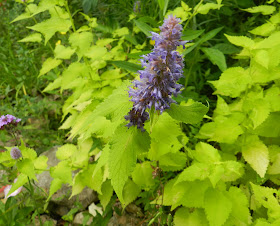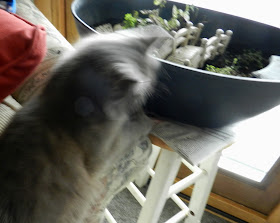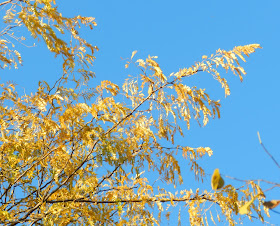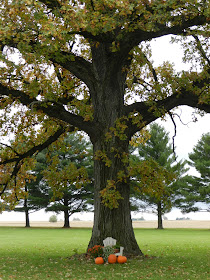Have you ever passed by someone's garden and just invited yourself in for a closer look? Or better yet, have you dropped in to visit a private garden,
when no one was even home? In a way, that is what two friends and I did on our way home from the Asheville Fling this past May.
The sign at the end of the driveway did say "Open," so we accepted the invitation and walked right in.
I suspect we were not the first visitors to be intrigued by this garden, for the front garden spills from the front of the house all the way to the street, enticing visitors to take a closer look. The glimpse of the blue bottle tree hints at other treasures within, just waiting to be found.
And indeed there are treasures, sometimes popping up unexpectedly as you round a path. Reminders that this is a garden where wildlife are welcome.
A garden where pollinators are encouraged to visit and feast on the variety of plants chosen just for them.
Though I didn't take a single photo of a real bee or butterfly visiting the garden, there was so much to see that I often forgot about the camera hanging around my neck. It was easy to get distracted--as we moved into the back garden, in fact, friend
Lisa, a birding enthusiast, heard a familiar bird song and went in search of the singer.
This is a garden where native plants and wildflowers abound, like this
Echinacea tennesseensis with its distinctive downward-curling rays. It may be on the Federal Endangered Species list, but it is thriving in its native habitat here.
Another native in bloom on this late spring day was the Phlox pilosa,
known to many of us in Blogland as PPPP.
Agastache (variety unknown, but maybe 'Golden Jubilee'?), also called Hyssop or Hummingbird Mint, is a favorite of hummingbirds and butterflies alike.
The native Hypericum adds cheery yellow blooms in this mostly shady garden.
While the emphasis is on natives here, other non-natives are welcome as well, such as this creamy daylily.
Or the Verbena bonariensis, which although not a native, is loved by the butterflies.
My friends and I didn't take advantage of this inviting bench to rest for a bit, but continued our exploration on foot. We wondered aloud what must the neighbors think of these three strangers roaming about the garden unchaperoned? Perhaps they are used to people stopping by to admire this native sanctuary, because no police ever arrived to arrest us for trespassing:)
By now, many of you no doubt recognize this garden as belonging to none other than the hostess of the monthly
Wildflower Wednesday, Gail of
Clay and Limestone. And to set the record straight, we didn't exactly drop in uninvited. When we made our plans to attend the Asheville Fling, friends
Lisa,
Beckie, and I also made plans to leave a day early and visit
Fairegarden, but left our return trip home more spontaneous. I was lucky enough to visit Gail's garden a few years before during another trip through Tennessee and raved about it, so Lisa and Beckie longed to see it, too. However, when we talked to Gail in Asheville, she said she was going to stay an extra day, but we were welcome to stop by her home anyway and tour the garden by ourselves. I'm not sure she really expected us to take her up on this offer, but we couldn't resist!
Thank you, Gail, for graciously allowing us to visit your garden, and thank you for hosting Wildflower Wednesday each month. I've learned so much about wildflowers and native plants through this series, including the
Hypericum above, featured in her post this month. My photos don't do her garden justice, but you can see much more of her garden as well as other wildflower entries posted this month
here. To paraphrase an old saying, when it comes to creating a pollinator-friendly garden, Gail doesn't just "talk the talk, she walks the walk"!


















































